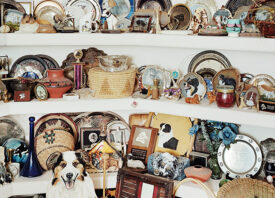Search this site
Haunting Images of an Annual Whale Kill in the Faroe Islands
The Faroese Whale Kill, a powerful collection of images by Denver-based photographer Benjamin Rasmussen explores the 400-year-old tradition of pilot whale killing in the Faroe Islands, a protectorate of Denmark. Tradition for tradition’s sake is, in the words of Rasmussen, “not a very compelling reason to continue it, but at the same time, pilot whales are not an endangered species and the small amount killed by the Faroese has no discernable impact on the population. It is an incredibly bloody and horrific spectacle, but so are the factory farms and slaughterhouses that raise American beef, pork and poultry. It is just that those abattoirs exist behind closed doors.”
Rasmussen’s images are as rich in reds as the dark sea is dense. The connection between human and animal feels stronger here, and the sea has a palpable life under it—its force tying Rasmussen’s lineage and this act together, as part of the same life source. We spoke in greater detail with Rasmussen about this complex event.
This practice indeed seems controversial, if not a bit ‘outdated’ in some ways, much like bull fighting in other parts of the world. Who usually participates in this killing and what is the given purpose of the event?
“The Faroe Islands is home to 48,000 inhabitants and traditional pilot whale killing still takes place there. Though it is very controversial internationally, the practice is valued and closely protected by the Faroese. Entire communities take part in the whale kill, known as “grindadráp,” and the meat and blubber is divided up equally between everyone in the village. Practiced in the Faroe Islands for centuries, records for the hunts go back to the late 1500s. The meat and blubber was once an integral part of people’s diets, but today it just supplements a much more standard European diet.
“The hunt begins when a pod of whales are spotted close to the islands. The community jumps into action and boats line up to block the whale’s path to the open ocean. Then they start hitting metal and wood against the boat hulls to herd the pod towards a predetermined and approved beach. Once the whales are brought to shallow water, they are hooked and pulled in. Then someone takes a special knife and cuts the whale’s spinal cord at the base of the brain, killing it instantly. After the whales are killed, the meat and blubber are divided up between those who took part in the hunt, with additional shares going to the needy in the community. No part of the whale is sold.”
You spent over a year in the North Atlantic. How was that experience? Did it shape you artistically?
“My father is from the Faroe Islands and I spent a few summers there as a kid and have lived there more extensively as an adult. I moved there for a year after finishing college and it is the first place where I worked as a photographer. Unfortunately I was immature photographically and did not produce any good work while living there, but my time there opened up doors that brought me back time and time again.
“And most importantly, that year introduced me to Faroese art. Faroese art, especially the Impressionist artists of the mid-20th century like Sámuel Joensen-Mikines and Frida Zachariassen, has had a massive influence on my aesthetic growth. This project is itself homage to Mikines’ paintings of whale kills and funerals from the 1930s and 40s.”
The stance feels very neutral, which is often a challenge in the contemporary photojournalism landscape. Tell us more about the experience.
“I had seen whale kills when I was young and ate whale meat and blubber throughout my childhood, but experiencing it as an adult and as a photographer was different. There was so much blood that it was difficult to not fall into the trap of making one-dimensional, thoughtless and gory pictures. But I wanted the images to represent the experience and not just some gruesome cliché. This project is not groundbreaking, but for me it was successful because many Faroese embraced it as a true representation of their experiences.
“One of the most compelling reasons for the practice to end is the increasing amount of mercury in whales due to the increasingly polluted oceans. In 2008, the Faroese chief medical officers declared it unsafe for consumption. This, combined with younger generations not liking the taste of the meat and blubber as much, will most likely spell the end for the practice.”
This post was contributed by photographer Sahara Borja.










